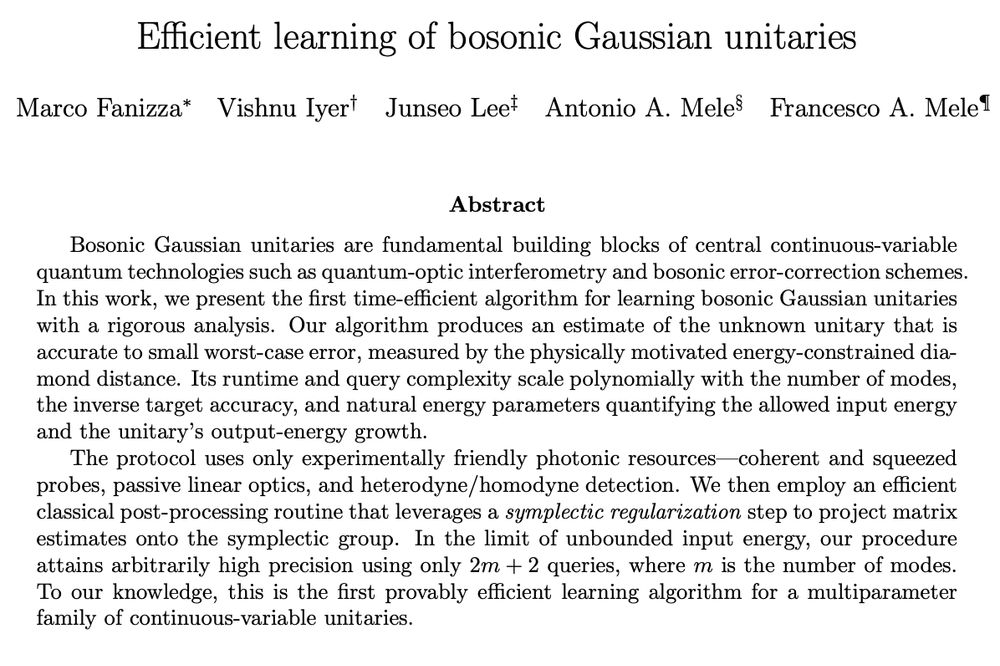This prize recognises early-career researchers who advance quantum information in new directions

This prize recognises early-career researchers who advance quantum information in new directions
Today's new work tackles another natural and central question in this rapidly developing field: Given an unknown CV state, how to test whether is it Gaussian or not?
arxiv.org/pdf/2510.07305
1/

Today's new work tackles another natural and central question in this rapidly developing field: Given an unknown CV state, how to test whether is it Gaussian or not?
arxiv.org/pdf/2510.07305
1/
And indeed, when you look closely at this field, many natural and promising questions arise. For instance:
How to learn CV Gaussian unitaries?
arxiv.org/pdf/2510.05531
1/

And indeed, when you look closely at this field, many natural and promising questions arise. For instance:
How to learn CV Gaussian unitaries?
arxiv.org/pdf/2510.05531
1/
arxiv.org/pdf/2510.03538
1/

arxiv.org/pdf/2510.03538
1/
This international award recognizes early-career researchers who are advancing quantum information science and engineering in new directions!
🔗 chicagoquantum.org/2025BQCP

This international award recognizes early-career researchers who are advancing quantum information science and engineering in new directions!
🔗 chicagoquantum.org/2025BQCP
If two probability distributions are ε-close in TV distance, how close are their mean vectors and their covariance matrices?
This is a natural question, but it has never been explored as far as we known
5/

If two probability distributions are ε-close in TV distance, how close are their mean vectors and their covariance matrices?
This is a natural question, but it has never been explored as far as we known
5/
If two (possibly non-Gaussian) states are ε-close in trace distance, how close are their covariance matrices, first moments, and symplectic eigenvalues?
Our new trace distance bounds precisely answer to this question:
4/

If two (possibly non-Gaussian) states are ε-close in trace distance, how close are their covariance matrices, first moments, and symplectic eigenvalues?
Our new trace distance bounds precisely answer to this question:
4/
Any n-mode Gaussian unitary can be written, for all k<n/2, as a composition of an n-mode passive Gaussian unitary, a Gaussian unitary that acts only on the first 2k modes, and another Gaussian unitary acting on the last n-k modes.
2/

Any n-mode Gaussian unitary can be written, for all k<n/2, as a composition of an n-mode passive Gaussian unitary, a Gaussian unitary that acts only on the first 2k modes, and another Gaussian unitary acting on the last n-k modes.
2/
A new decomposition of Gaussian unitaries and new bosonic trace distance bounds (the saga of bosonic trace distance bounds never ends! 😍)
arxiv.org/abs/2504.19319
1/

A new decomposition of Gaussian unitaries and new bosonic trace distance bounds (the saga of bosonic trace distance bounds never ends! 😍)
arxiv.org/abs/2504.19319
1/
If a state has high symplectic rank, then all states sufficiently close to it (with bounded "energy") have high symplectic rank.
11/

If a state has high symplectic rank, then all states sufficiently close to it (with bounded "energy") have high symplectic rank.
11/
9/

9/
6/

6/
For example, it immediately implies that no Gaussian protocol can convert a single-mode non-Gaussian state into the tensor product of two non-Gaussian states. Or, more generally, see Corollary 5 below:
5/

For example, it immediately implies that no Gaussian protocol can convert a single-mode non-Gaussian state into the tensor product of two non-Gaussian states. Or, more generally, see Corollary 5 below:
5/
In other words, it cannot increase under any Gaussian protocol, even with the ability to post-select on the outcome of Gaussian measurements.
4/

In other words, it cannot increase under any Gaussian protocol, even with the ability to post-select on the outcome of Gaussian measurements.
4/
3/

3/
2/

2/
Take the covariance matrix of a pure state and count the number of symplectic eigenvalues that are strictly larger than one: this is a powerful non-Gaussian monotone — the *symplectic rank*
arxiv.org/abs/2504.19319
1/

Take the covariance matrix of a pure state and count the number of symplectic eigenvalues that are strictly larger than one: this is a powerful non-Gaussian monotone — the *symplectic rank*
arxiv.org/abs/2504.19319
1/
6/

6/
5/

5/
4/

4/
3/

3/
What is the maximum energy that you can extract from a quantum state via Gaussian unitaries only?
We solve this problem by establishing a simple, cute formula for the *Gaussian ergotropy*.
1/
arxiv.org/abs/2503.21748

What is the maximum energy that you can extract from a quantum state via Gaussian unitaries only?
We solve this problem by establishing a simple, cute formula for the *Gaussian ergotropy*.
1/
arxiv.org/abs/2503.21748
7/

7/
6/

6/


